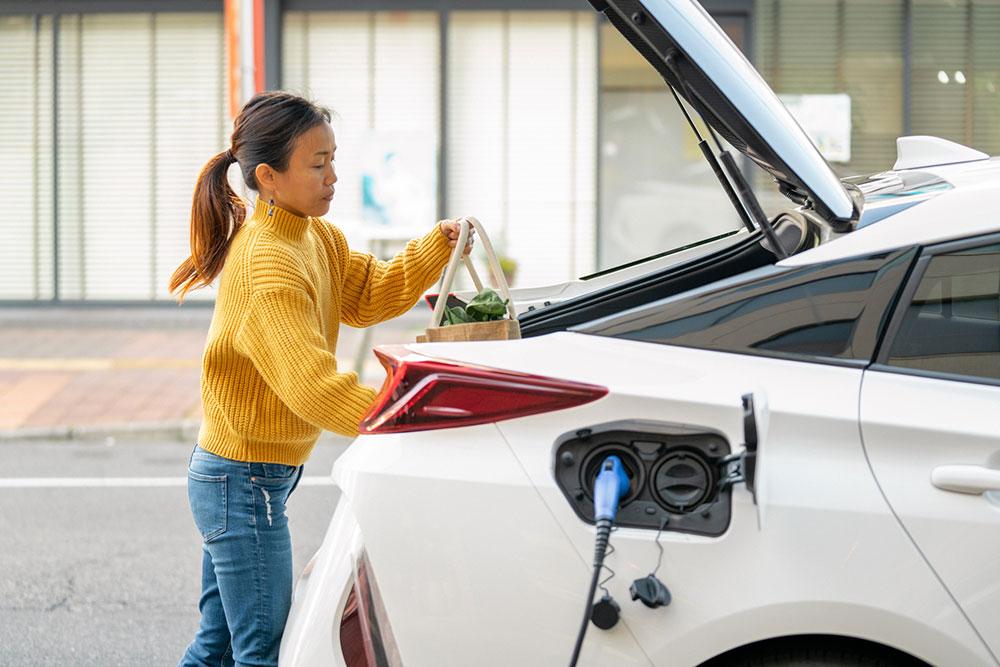Your electric car questions answered
Everything you need to know before buying an electric car.

As more models enter the market and fuel prices rise to unprecedented levels, interest in electric cars continues to grow.
Here are some answers to questions RACQ regularly gets asked about battery electric vehicles (BEVs), or simply EVs, as they are otherwise known.
What is RACQ’s position on EVs?
- RACQ encourages the take-up of all low-emission vehicles, regardless of the technology they use.
- RACQ believes that EVs, as their price comes down, will inevitably become much more common.
- BEVs are only one potential solution to reducing vehicle emissions issues, hybrid vehicles are another, as is minimising driving, and walking and cycling where possible.
What is the difference between an EV, a hybrid vehicle and an EV with range extender?
Hybrid vehicles, plug-in hybrid vehicles (PHEV) and electric range extender vehicles, utilise a combination of both internal combustion and electric drive trains, while an EV (sometimes referred to as a battery electric vehicle or BEV) only has an electric drive train to power the vehicle.
The most significant aspect for the owner is hybrids are simply an efficient petrol or diesel car, while PHEV and range extenders have limited EV range and rely on petrol or diesel for longer distance trips. When they run out of battery power, they can still be driven by the combustion engine.
This is not the case with EVs which are full electric. EVs are increasing in their range (now between 350km to 550km), but on longer trips need to rely on the availability of fast and ultra-fast charging.
How ‘green’ are EVs?
While EVs produce no tailpipe exhaust emissions and are super energy efficient compared to petrol and diesel cars, the power source for battery charging can produce CO2 emissions. Surveys show that the majority of EV owners also own solar PV. Actual CO2 emissions from charging vary from state to state depending on the source used for electricity generation.
As the electricity grid transitions to renewables the driving emissions of EVs also becomes cleaner.
With petrol and diesel cars there is tailpipe CO2 emissions and emissions involved in the production and transport of petrol and diesel. Like all vehicles there are emissions involved in mining resources, manufacturing of plastics and manufacturing of steel and alloys to build the vehicle. However, ‘well to wheel’ and over the lifespan of the vehicle, an EV has a much lower emissions footprint than an ICE vehicle.
To compare an EV’s CO2 emissions with the combined cycle CO2 emissions of a conventional vehicle, multiply the EV’s energy consumption (Wh/km) by 0.8**
Example:
117 Wh/km x 0.8 = 93.6 g/km
The result can then be compared with the combined cycle CO2 emissions of a conventional vehicle as listed on the Green Vehicle Guide. (This example would equate to a petrol-powered vehicle with a fuel consumption of about 4.0 l/100km)
**Applies to vehicles operating in Queensland. This figure may be different for other states. Current as of July 2021. Scope two electricity emissions, source https://www.cleanenergyregulator.gov.au/ .
Why aren’t EVs more common?
In 2019, EV sales represented less than 1% of total Australian vehicle sales. Currently, it is around 3%. The rate of adoption of EVs is likely to follow an ‘S curve’ which we see with most new consumer products and as we have seen with EV adoption overseas.
Likely reasons for this include:
Limited model range and high prices
- EV and battery technology is still relatively expensive, but we are seeing greater competition and some signs of price reductions. As new vehicle models and players enter the market, we will likely see costs and prices driven down to reach price parity over the next 3 to 7 years. However, as technology can change rapidly, this may change sooner.
- Limited supply to Australia due to lack of fuel efficiency standards.
- EVs need to align with buyer expectations of price points, equipment levels, running costs, value proposition before they gain widespread acceptance.
Long charging times if no fast-charge facility is available
- Most EVs owners top up their EVs battery when it’s convenient when the car is parked, such as at home, at work or at free chargers at shopping centres.
- Full charging times typically range from less than 30 minutes at ultra-fast chargers to one hour plus at fast chargers to 10 hours plus at home using a 7kW home charger.
- Ultra-fast chargers are being rolled-out and provide compatible EVs with a full charge in around 20-30 minutes, however the electricity infrastructure they require is limiting the speed of the roll-out.
Range anxiety and public perceptions of EV practicality
- At present EV range (200km to 570km) is typically less than many conventional vehicles would travel on a full tank. Like conventional vehicles, the quoted power consumption and therefore range, is largely dependent on battery capacity, road and weather conditions and how the vehicle is driven. Models with greater range are typically dearer than those with less range.
- The range numbers quoted in the Green Vehicle Guide are likely to be achievable only under ideal driving conditions.
- New EVs have more than enough range to cover the daily travel needs of many drivers, but at present the practicalities of longer or more remote trips will be dependent on vehicle’s effective range and availability of fast and ultra-fast charging infrastructure.
- The range of EVs that can tow are generally limited, particularly for towing loads that are not aero-dynamic.
- The buying public needs to become comfortable with the technology before there is widespread take-up. This is common with all new technologies.
Charging options
- EV owners tend to mostly ‘top up’ (90%) at home rather than stopping for ‘fill ups’ like petrol and diesel car owners. A mix of home and commercial recharge facilities will be needed to satisfy the needs of most users.
- Home charging is slow due to limitations on available power or come at additional cost due to the need for a home charger that can provide quicker charging.
- Commercial fast and ultra-fast charging infrastructure is being rolled out across Queensland however, ultra-fast chargers are limited in many regional areas.
Market segment limitations
EVs are currently not offered in Australia, or have limited offerings, in some popular market segments, such as utilities and off-road vehicles. Over time we will see an expanded range of models and offerings in different market segments.
Uncertainty about battery life and replacement cost
- The option to repair faulty batteries rather than replace them is not yet in place to any great extent.
- Battery life of new EVs is expected to last the lifetime, if not longer than the car itself, that being said, over time there will be some loss in range (10% to 25%) depending on whether the battery is air or liquid cooled, the battery chemistry and the way the car has been charged and driven.
- The battery represents a significant part of the vehicle’s value. Replacement of batteries are highly unlikely to be needed with new EVs. Replacements though are expected to be high and would likely exceed the value of an older EV. However, this is no different to an older ICE vehicle needing a major replacement of an engine or driveline component.
- Battery warranties are generally about eight years and when buying a second-hand EV it is worth checking the battery state of health.
- The option to repair faulty batteries rather than replace them is not yet in place to any great extent.
Uncertainty about vehicle resale and residual value
- COVID, the war in Ukraine, limited EV supply, supply chain issues and until recently, lack of Government policy, has meant that EVs currently have very good resale values though this is expected to normalise. Petrol and diesel car resale values are also higher for largely the same reasons though as the transition to EVs speeds up it is expected that values in segments that become dominated by EVs will see greater reduction in value.
How long are EV battery warranties?
Expect traction batteries to have a longer warranty than the rest of the car, typically this is about eight years. However, many vehicle manufacturers have very specific conditions, including what they consider to be an acceptable loss of battery capacity.
How do I find recharging facilities?
There are several online tools for locating recharging facilities. Plugshare and Chargefox are a couple of them. On-board navigation systems are also likely to show charging stations.
Almost all EV manufacturers use Type 2 plug arrangements with some Japanese brands using CHADeMo, however most commercial charging facilities (except those dedicated to a specific brand) should be able to accommodate both types.
How does the electricity cost for an EV compare with fuel consumption of a conventional car?
For most people the simplest and most meaningful comparison will be the cost to travel 100 km.
For an EV:
Wh/km* ÷ 10 = kWh/100km
kWh x applicable electricity tariff = $ / 100 km
Example:
117 Wh/km ÷ 10 = 11.7 kWh
11.7 x 0.266** = $3.12 /100km
*Available from the Green Vehicle Guide.
**Based on Qld Tariff 11 of 0.266 c/ kWh. Note: Tariffs can vary. Commercial charge stations often charge more.
For a conventional vehicle:
L/100km * x fuel cost ($/L) = $ / 100 km
Example:
7.5 x $1.80 ** = $13.50 / 100 km
* Use combined cycle fuel consumption figure for the chosen vehicle from the Green Vehicle Guide.
** Example of fuel cost only. Substitute as applicable.
How far can an EV be driven on a single charge?
This is known as operating range and is listed in the Green Vehicle Guide for each EV.
Note, however, the range numbers quoted are likely to be achievable only under ideal driving conditions.
How do maintenance costs of EVs compare with conventional ICE models?
EVs have fewer drivetrain parts than a conventional vehicle and will therefore require less maintenance. However, EVs will still require replacement tyres and some level of repair and servicing to things like steering, suspension, and brake systems, so they will not be entirely maintenance-free. This could have a major impact on the future profitability of repair facilities but will be a plus for EV buyers. The potential for greater battery degradation than average after expiry of the vehicle’s warranty could be a factor in future resale value.
Are EVs safe?
EVs are designed and built to recognised international standards and have been proven to be safe in service. All vehicles have some level of fire risk, and while EVs do not have a higher fire risk compared to petrol or diesel cars it is worth becoming familiar with risks that relate to EVs.
Technicians are specifically trained to repair and service these vehicles and DIY repairs on the high voltage systems are not encouraged.
Many EV models have been subjected to independent crash testing by ANCAP (Australasian New Car assessment Program), similar to petrol and diesel models. Buyers are encouraged to check the ANCAP rating for models they consider and choose five-star rated cars with the latest test date stamp.
Things to note: The information in this article has been prepared for general information purposes only and is not intended as legal advice or specific advice to any particular person. Any advice contained in the document is general advice, not intended as legal advice or professional advice and does not take into account any person’s particular circumstances. Before acting on anything based on this advice you should consider its appropriateness to you, having regard to your objectives and needs. Information provided as of February 2023.
Related topics
Things to note
The information in this article has been prepared for general information purposes only and is not intended as legal advice or specific advice to any particular person. Any advice contained in the document is general advice, not intended as legal advice or professional advice and does not take into account any person’s particular circumstances. Before acting on anything based on this advice you should consider its appropriateness to you, having regard to your objectives and needs.
Insurance Products (excluding Travel Insurance) are issued by RACQ Insurance Limited ABN 50 009 704 152 (RACQI) and arranged by its agent, RACQ Distribution Services Pty Ltd (RDS) ABN 35 116 361 650, AFSL 567130 and RDS' authorised representatives (including RACQ Operations Pty Ltd ABN 80 009 663 414, AR No. 234978 (RACQO). Conditions, limits and exclusions apply. RDS and RACQO are in the RACQ group of companies. One of the companies in the RACQ group of companies has a minority shareholding in RACQI.
RDS and RACQO have not taken your personal objectives, circumstances or needs into account when preparing advice regarding insurance products and you will need to consider whether the advice is appropriate for you. Read the Product Disclosure Statement (PDS) and any applicable Supplementary PDS before making a purchase decision on this product. You can also access our Target Market Determinations on this website. RDS receives a commission from RACQI for the policies it arranges. RACQO receives fees paid for services it provides to RDS. Further details about remuneration are available on request prior to purchasing.
Banking and loan products issued by Members Banking Group Limited ABN 83 087 651 054 AFSL/Australian credit licence 241195 trading as RACQ Bank. Terms, conditions, fees, charges and lending policies apply. This is general advice only and may not be right for you. This information does not take your personal objectives, circumstances or needs into account. Read the disclosure documents for your selected product or service, including the Financial Services Guide and the Terms and Conditions, and consider if appropriate for you before deciding.
Except for RACQ Bank, any RACQ entity referred to on this page is not an authorised deposit-taking institution for the purposes of the Banking Act 1959 (Cth). That entity’s obligations do not represent deposits or other liabilities of RACQ Bank. RACQ Bank does not guarantee or otherwise provide assurance in respect of the obligations of that entity, unless noted otherwise.
RACQ Bank subscribes to the Customer Owned Banking Code of Practice which establishes higher standards than the law requires. The Code reflects modern consumer expectations and developments in approaches to issues such as consumer vulnerability, guarantors, and supporting customers through financial hardship. Please read our Customer Owned Banking Code of Practice page for more information.
RACQ Operations Pty Ltd (ABN 80 009 663 414 AR 000234978) and Members Travel Group Pty Ltd (ABN 45 144 538 803 AR 000432492) are acting as an Authorised Representative of the issuer of the insurance, Tokio Marine & Nichido Fire Insurance Co., Ltd. (ABN 80 000 438 291 AFSL 246 548). Any advice set out above is general in nature only, and does not take into account your objectives, financial situation or needs. Before purchasing any travel products, please consider the RACQ Travel Insurance Product Disclosure Statement (PDS) and the Target Market Determinations (TMDs) that apply to these products. Whilst the PDS outlines the Terms and Conditions of these products, the TMDs outline the intended class of customers that comprise the target market for these travel products. This will allow you to consider which products best suit your objectives, financial situation and needs and consider the products appropriateness to your personal circumstances. TMDs also outline matters involving the distribution and the review of these products. The PDS, Supplementary PDS and TMDs for each travel product can be found here.

